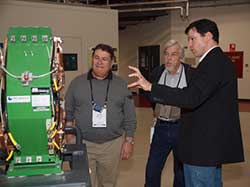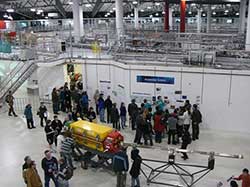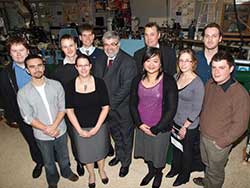Accelerators in Australia
Mark Boland

Mark Boland (R) leads a tour of the Australian Synchrotron for CERN Director General Rolf Heuer (C) and CERN Director of Research and Computing Sergio Bertolucci (L) during ICHEP 2012 in Melbourne after the Higgs particle discovery was announced.

Open Day 2010 at the Australian Synchrotron with a keen interest for the accelerator science displays.

Australian Minister for Science Kim Carr (second from the left) surrounded by accelerator science students at the launch of ACAS in 2010, Kent Wootton standing behind Kim Carr.
Accelerator physics in Australia has been undergoing a renaissance in the past decade, spearheaded by the Australian Synchrotron light source, a user facility in operation since 2007. The $200M laboratory located in Melbourne is the latest in a series of research accelerators that have serviced the science community since the pioneering days of particle accelerators [1]. Australians were part of the early development of high energy accelerators led by Mark Oliphant. Oliphant, during his time in Birmingham (1937 – 1945) designed the proton-synchrotron, in which particles could be accelerated to GeV energies. [2, 3, 4] This work was based on the 'phase stability' principle, which he conceived before Vladimir Veksler and Edwin McMillan.
Oliphant’s pioneering invention did not lead at that time to the construction of synchrotrons in Australia; however more recent work is putting Australia back on the map. Australia now operates over 200 particle accelerators, from radiation therapy electron linacs and cyclotrons for producing radiopharmaceuticals, to heavy ion accelerators for studying exotic nuclei and Accelerator Mass Spectroscopy. In 2011 the Australian Synchrotron storage ring set a new world record low for vertical emittance coupling [5], research motivated by the requirements for the damping rings for the next generation e+-e- linear collider. This achievement of sub-picometer vertical emittance led to the development of a new emittance measurement technique using a vertical undulator [6]. Recent results from Melbourne indicate the quantum limit of vertical emittance has been reached and thus demonstrates the designs for future linear colliders are indeed feasible.
Kent Wootton, the PhD student responsible for the sub-picometer vertical emittance research, has accepted as a postdoc position at SLAC working in the Advanced Accelerator Research Division on the accelerator on the chip project [7]. This new position will build on past collaboration between Australia and SLAC, including the precise beam energy measurements conducted by Kent on both sides of the Pacific Ocean [8]. I am Kent’s thesis supervisor and will join him there for six months starting in August 2014 to work on short pulse experiments at SPEAR3 and LCLS.
ACAS, the Australian Collaboration for Accelerator Science, coordinates activities between the four largest research laboratories in Australia; the Australian Synchrotron, the Australian Nuclear Science and Technology Organisation, the Australian National University and the University of Melbourne. One of the main missions of ACAS is to grow the local accelerator physics community, and it has done so by running summer schools to pique the interest of university students. Four schools have been run since 2008 and provide introductory accelerator physics lectures and laboratory classes. The more advanced students go on to attend international schools like the US Particle Accelerator School (USPAS), the CERN Accelerator School (CAS) and the International School for Linear Colliders. Each school has attracted several students into graduate research projects and they have gone on to work in the field of accelerators at hospitals, in industry, for government agencies for radiation protection and calibration, accelerator operations and accelerator research.
In recognition of the importance of the field of particle accelerators, the Australian Academy of Science as part of a Future Science program has commissioned an expert panel to write a report on how Australia should continue to develop its accelerator facilities. The world trends suggest these plans will include hadron therapy machines for treating cancer, new light sources such as ultimate storage rings and free electron lasers, participation in international linear collider collaborations and developing the existing user facilities for X-ray and nuclear physics beams. With all the local and worldwide activities in accelerator physics research and development, there are ample reasons for Australia to consolidate its achievements from the past and look forward to a bright future in the field.
References:
[1] T.R. Ophel, A history of accelerators in Australia, Nuc. Instrum. and Methods A382, 20 (1996).
[2] J. Rotblat, Obituary: “Mark Oliphant (1901-2000),” Nature 407, p. 468 (2000).
[3] E. Wilson, “An Introduction to Particle Accelerators,” Oxford University Press, Oxford, p. 12 (2001).
[4] A. Sessler and E. Wilson, “Marcus Laurence Elwin Oliphant (1901–2000),” in Engines of Discovery, Chapter 5, p. 56, World Scientific (2007).
[5] R. Dowd, M. Boland, G. LeBlanc, and Y-R. E. Tan, “Achievement of ultralow emittance coupling in the Australian Synchrotron storage ring,” Phys. Rev. ST Accel. Beams, 14(1):012804, Jan (2011).
[6] K.P. Wootton, M. J. Boland et al., “Observation of picometer vertical emittance with a vertical undulator,” Phys. Rev. Lett. 109 (19), 194801 (2012).
[7] E. A. Peralta, K. Soong, R. J. England, E. R. Colby, Z. Wu, B. Montazeri, C. McGuinness, J. McNeur, K. J. Leedle, D. Walz, E. B. Sozer, B. Cowan, B. Schwartz, G. Travish, R. L. Byer, “Demonstration of electron acceleration in a laser-driven dielectric microstructure,” Nature, 2013; DOI: 10.1038/nature12664
[8] K. P. Wootton, M. J. Boland et al., “Storage ring lattice calibration using resonant spin depolarization.” Phys. Rev. ST Accel. Beams, 16(7):074001 (2013).
Mark is a Principal Scientist in Accelerator Physics at the Australian Synchrotron and a Principal Fellow at the University of Melbourne where he teaches and supervises student projects. To coordinate the recent developments in accelerator physics in Australia and the international collaborations with labs like SLAC, CERN and KEK, Mark helped found and is a director of ACAS – the Australian Collaboration for Accelerator Science.
Disclaimer - The articles and opinion pieces found in this issue of the APS Forum on International Physics Newsletter are not peer refereed and represent solely the views of the authors and not necessarily the views of the APS.
